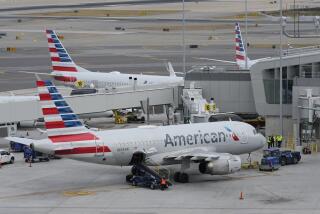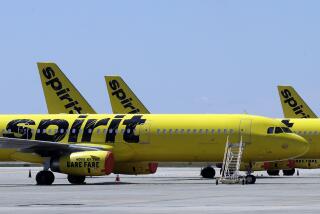Merger of American Airlines and US Airways cleared for takeoff
American Airlines and US Airways moved another step closer to creating the world’s biggest carrier but had to make concessions to help ensure the deal wouldn’t lead to service cuts and higher fares.
The Justice Department said Tuesday the agency would back the $11-billion combination under an agreement that the airlines give up dozens of gates at major hubs including New York, Washington and Los Angeles. Both sides heralded the agreement as a boon to consumers because those gates must be auctioned off to low-cost competitors.
But the agreement left some analysts and consumer rights groups wondering if the merger would really benefit travelers.
“I wouldn’t bet the farm on it,” said John Briggs, an antitrust attorney with Axinn Veltrop & Harkrider and managing partner of the firm’s Washington, D.C., office. “Everyone is going to put a smiley face on the deal.”
The merger would create an airline behemoth that shuttles 140 million passengers around the world each year, and employs about 90,000 full-time workers operating about 951 airplanes. The new airline would keep the name American Airlines, though US Airways’ chief executive would remain in charge.
FOR THE RECORD:
An earlier version of this article incorrectly said that the merged companies would have about 900,000 employees. The correct total is about 90,000.
After the merger is completed next month, four airlines — Delta, United, American and Southwest — will control nearly 70% of the nation’s domestic air traffic.
Wall Street liked the deal. Shares of AMR Corp., the parent company of American Airlines, shot up about 26%, or $2.48, to $12 on Tuesday after the government backed the deal. US Airways Group Inc. shares rose 1.1%, or 25 cents, to $23.52.
But some antitrust experts wondered whether the Justice Department gave up too easily.
The government vowed to ground the merger when it sued the two airlines in August. The Justice Department contended the combination would reduce competition and lead to higher fares and less service to smaller cities.
Still, the government capitulated just two weeks before a trial was scheduled to hear the lawsuit.
“The Justice Department blinked,” said Jeffrey I. Shinder, an antitrust attorney and managing partner at Constantine Cannon’s New York office. “The defendants did well in this deal.”
To settle the Justice Department’s challenge, American and US Airways agreed to give up landing slots and gates at seven key airports, particularly at Ronald Reagan Washington National Airport and New York LaGuardia Airport.
By ensuring that low-cost airlines take over those gates and slots, Assistant Atty. Gen. Bill Baer said airline passengers could expect fares to remain competitive and service to continue at smaller cities.
“This settlement will disrupt the cozy relationship among the incumbent legacy carriers, increase access to key congested airports and provide consumers with more choices and more competitive airfares on flights all across the country,” he said.
American and US Airways executives called the loss of gates at those key airports “painful” but said the settlement still allows the merger to generate more than $1 billion in savings and “synergies” beginning in 2015.
“We’d rather not divest those slots but we think this will still be the world’s best airline network,” said Doug Parker, chief executive of US Airways.
The biggest concern raised by the Justice Department was that the newly merged airlines would control 69% of the landing slots at Ronald Reagan airport. Under the deal, the two airlines must give up 104 landing slots, or about 15% of the slots at the airport.
American and US Airways must also give up 34 slots at New York LaGuardia Airport. The new airline will also give up two gates at each of the following airports: Boston Logan, Chicago O’Hare, Dallas Love Field, Los Angeles International and Miami International.
The Justice Department made it clear that the airlines must sell the slots to low-cost carriers. Southwest Airlines and JetBlue Airways have said they are interested in bidding for those slots to expand their service into Ronald Reagan and LaGuardia airports.
At LAX, the new American Airlines would be the largest carrier, with about 19% of the passenger traffic. It would surpass its closest competitor, United Airlines, with nearly 17%.
In the last few weeks, American had pressed the Justice Department to settle. But Baer said politics did not play a role in his agency’s decision to reach a settlement.
The lawsuit originally was supported by seven states and the District of Columbia, but Texas Atty. Gen. Greg Abbott pulled Texas out of the suit after American Airlines agreed to maintain scheduled daily service to more than 20 Texas airports.
And employee unions at American and US Airways organized rallies to call on the Justice Department to drop its lawsuits. Also, the mayors of six cities and a county with major airline hubs wrote a letter to the Justice Department, voicing support for the merger.
It put pressure on the Justice Department, the “likes of which I’ve haven’t seen in 40 years,” said Briggs, the antitrust lawyer. Critics of the merger say the concessions are not enough to offset the higher fares the airlines will adopt with the further consolidation of the industry.
“What I see is an oligarchy,” said Rich Gritta, a professor of finance and transportation at the University of Portland. “These airlines are not in the business to be nice guys. They want to make money, and this merger is going to make them money.”
The concessions could help boost competition but “we’re still very concerned about a marketplace dominated by larger airlines that are essentially too big to fail,” said William J. McGee, travel and aviation consultant for Consumers Union, the policy and advocacy arm of Consumer Reports. “The merger could still leave smaller markets underserved with fewer choices for flights.”
Parker, the US Airways CEO, disagrees, saying even after the merger, American will continue to battle low-cost airlines to remain competitive.
“Low-cost airlines are already pricing us out at almost every market,” he said. “It doesn’t change the competitive dynamics.”







